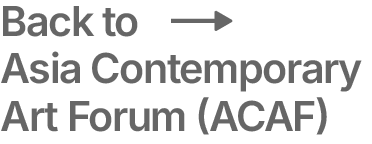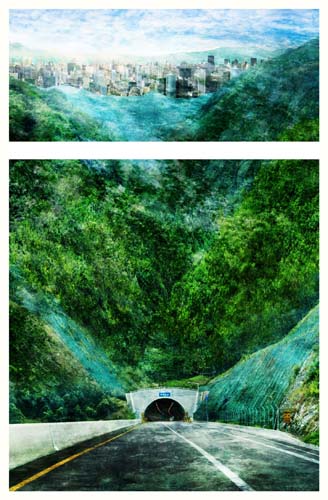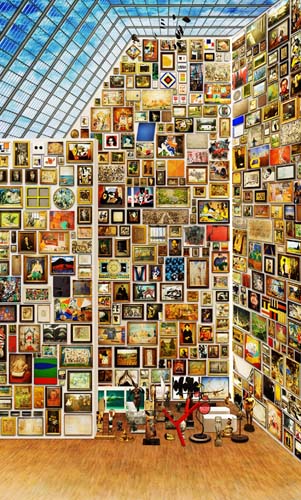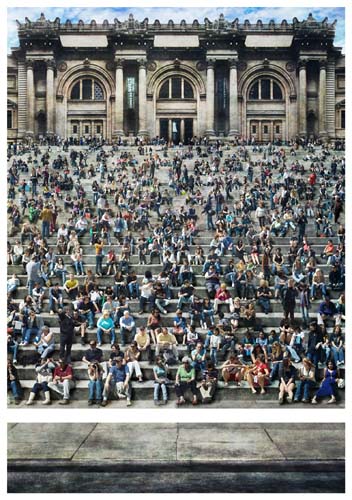Interview with Sangbin IM
1.How did you start making art?
I do not remember the exact moment. My mother told me that she remembers since I was little, painting was my love and it continued every single day. As I also vaguely remember, whenever I finished the works, my mom put them up on all the walls of my house, then onto the ceilings. My works became the wallpaper of my family house, where each individual piece served in what became a big installation. As I look back, this was a formative experience: this collaborative installation at such an early age helped me develop my ongoing interest in the relationship between individual units within a larger whole.
At the earliest age that I could remember, I would like to say that my mind was somehow already made up as an artist, and since then, it has never changed. From the age of three throughout my elementary school days, I continued attending art institutions. Many art teachers urged me to apply for art middle school. So, I ended up going to art middle and high school before entering the Department of Visual Arts at Seoul National University. After graduation, I envisioned pursuing my studies abroad, so I went to art school at Yale University where I received an MFA in the department of Painting and Printmaking. Afterwards, my interest in sociological aspects of the artist, art, and the market led me to pursue a doctoral degree at Teachers College, Columbia University. This degree kept my curiosity growing as an artist who would like to know better about my own art and how it fits in today’s world.
Tunnel-NY, 15×35 inches(top). 37.5×35 inches(bottom), 2009
2.Briefly describe your art from the perspective of what it could tell us about you?
I do not like to frame and limit my interests. I like them to flow around and expand, so I have developed many projects over the years. However, at this point, I would like to say that my main projects are People Project, Museum Project, and Cityscape Project. These projects tell a mixture of my impressions/expressions such as my fascination and anxiety of the spectacle of the modern megalomaniac city, institution, or other cultural sites that are driven and constructed by a capitalistic desire or vision, that stage and condition people in the way they live, work, and enjoy life. From this constant interest of mine, I would say that these projects indicate that I am the person who likes to live and work in cosmopolitan cities such as New York and Seoul, while being somewhat critical about those cities. In other words, I appreciate the contemporary spectacle. In the meantime, some aspects of it seem thought-provoking or problematic. As an artist, I desire to visualize both via my own artistic way of seeing and acting in the world.
3. What experiences have most influenced your choice of subject matter, medium and style?
Even though my major has always been painting, my interest in the digital language goes back to my military days from winter 1996 through spring 1999. Before the military, I did not know much about computers. I did not even know how to save a digital file. However, in the military, I suddenly became very good at using computers, simply because I had to. One of my jobs was to draw an electronic map for military action. When I drew an electronic line, minutes later or days later, soldiers actually followed the line! Digital came first and analog followed. The perception of signal play preceded the imagination of the impact of actual physicality out there somewhere. (this last sentence is confusing, what does she mean?) This relationship between the virtual and the real fascinated me and finally made me seek ways to incorporate digital language into my traditional art making after finishing my military service.
Modern Art, 80×48″, 2009
In the meantime, my interest in the boundaries between reality and fantasy came from three major experiences which I often talk about. First, in 1982, I was conversing with my friend on a bridge. I was standing and he was on a bike. Suddenly with a slight misstep on the rail, he fell off the bridge in front of my eyes. Second, in 1995, I was driving with my mom and younger brother. I was about to park by the Sampung department store to have dinner, when my mom suddenly suggested that the adjacent shopping center actually had a place that served the same menu with more delicious food and so we went to the other restaurant. The department store that we were originally going to go to suddenly collapsed; it was later revealed that faulty concrete cause the accident. Third, in 2003, my first day in New York was during the historic East Coast blackout and I wondered around with mixed feelings. The ‘nonstop city,’ as the world knows it, seemed suddenly so far away from actuality. These experiences directed my attention to the larger system that is capable of making individuals thrive or get lost. In addition, the tragic, surreal accidents blurred my perception of the boundary between real and fantasy. Finally, the architectural condition of the city in which we are all bound up together became one of my artistic subjects of pondering.
4.Is your formal or informal training as an artist useful? How?
Yes and No. I have never stopped creating art except during my military days. Probably, I would have not gotten my hands as experienced as they are now without my intense formal training. I have studied at art focused schools since my childhood. By the time I reached the college level, I realized that university entrance exams in art were often not only boring but too rigid. So, I had to back out a bit to reboot my creative energy. My undergraduate art school did not even have a photography major, yet to me, photography was a really intriguing medium. My rationale at the time was that photography was more about ideas than the magic of hand. Moreover, by not using my hands too much, I would have the time and the chance to cleanse or reformat my hands from past training.
Of course, as a painter, my approach to photography was different from many traditional photographers. My interest was not to take or to capture photos, but to make or construct them. My concern was not the manipulation of the original image, but the construction based on photographs of real objects to create a visualization of my world. Likewise, I have actively incorporated the painting language into photography, and my works have a painterly surface. Interestingly, more people think of me as a photographer. However, in my mind, I am an artist who uses a hybrid of media as a tool for my art. This year, I will be making more paintings than before. I will not frame my relationship to a specific media but open it up for more possibilities.
5.Does your work reflect issues in yourself, in society or community? What would you say is the purpose for making art?
I would like to say consciousness is the fatal human condition. Due to its existence, we constantly seek meaning simply because we need to or have to find it. The lack of it may cause us emotional trouble such as emptiness or depression. I would like to visualize the way I see and review the world, as I desire to project and share it. If doing my art is meaningful to me, and if the meaning reverberates, it is very fulfilling. My subject is to review our human condition in the world of modern spectacle, but I certainly anticipate many meanings generated and shared by the viewers. Different understandings of my art are welcomed as it may always expand the horizon.
6. Do you appreciate culturally specific works of art? If so how does your personal and cultural background show up in your work?
Culture-bound perception often defines and projects who I am and how I think. My artwork is not only individualistic but also collective and may have originated from the Korean culture of collectivism and connectedness. In addition, the state of the Korean IT industry may have influenced me to pay special attention to digital language in art making. (Seoul is one of the most digitally connected cities in the world). However, it is only one component that has influenced my work. As I have been raised in a modern city delineated by skyscrapers, my interest in modernity has been incorporated in an important body of work that is Cityscapes. My personal and cultural background is more overtly shown in my work from this series, such as Tunnel – NY where the two cities I call home, NY and Seoul, are bridged together, both visually and mentally. Though many of my subject matters deal with places in Seoul and New York that are biographically significant, these specific places are mere stages to investigate and explore my interest in 21st century visual culture.
7.Is there anything you would like to say about your local art scene or the international art market, art education, and or system for art exhibition?
Some people would like to mystify or separate doing art from other activities. Others seem to overemphasize the business side of art. Either way, art may lose its rich layers of contextual meanings in the world. The purity of art cannot be simply tainted by the business of art. Art does not exist alone and the world makes various contexts for art to live. We do art as we like it and the world needs it. The meaning of art is not fixated but varies with regard to how we make sense of it. The so-called art world and art market condition art in various ways. We should constantly redefine what art is and how it is meaningful. Some people worry that too much money has flown into the art world, but a bigger pie may be better for art to thrive. Some people worry that the market could kill the true meaning of art, but it may add more layers of meaning to it. Some people regard making art as a competition to win, but if art is life, doing art may contribute to artistic development and personal growth in the world. After all, it is of significance to know how the world is shifting, and at the same time, to envision how we can create art more meaningfully. There’s got to be a way, always.
8. How does your current portfolio fit into the rest of your body of work?
People Project, Museum Project, and Cityscape Project are my current main projects. However, I continue other projects and tomorrow’s projects are definitely unknown, but that makes them so enthralling. In my case, as one project develops, it often leads to another. For instance, as of today, Paintings Project is a recent project and another branch of my current People Project.
People Project stages numerous people who are cultural nomads in this global world. They are not glamorous people, but everyday ordinary ones on the street who wear casual outfits for convenient travel. They happened to be present at the site during my shooting and were busy enjoying a cultural spectacle such as a museum exibition, a tourist hub like Times Square, or a sporting event. Each person is shot individually and placed in the composition to create possible relationships and fictive narratives. They have their own stories, but as a whole, they signify and energize the site, and represent a global culture.
The people in Paintings Project are actual painted figures from various artworks, such as from Old Master paintings. In the original paintings, these figures are the main subjects as part of an acceptable canon of appropriate subject matters such as Madonna and Child, female nudes, gods and goddess in mythology, etc. They are often portrayed with great theatricality: their draped clothing to show form, deep facial expressions, contoured bodily gestures, dramatic lighting, or other clever ways to heighten reality. Throughout art history, many artists had to paint the same figure again and again as that figure sold well for its time. By placing similar painted subjects such as female nudes, male nudes, or Madonna and Child on the same stage, the project is about revealing the artistic variations among artists portraying the same characters.
Likewise, the two projects share their similarities and differences, so the tension between the ordinary and the theatrical is heightened and the meaning of both projects is expected to expand. There are many other projects in my mind that may or may not be realized; therefore, they will have to be discussed at another time. In art, I accept the fatal fact that nothing is fixed but everything is in constant motion. This uncertainty amuses me and also motivates me to keep on going.
People-Met Museum, 57×48, 10×48 inches, 2010





